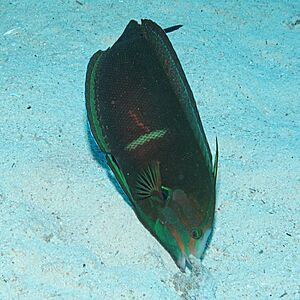African wrasse facts for kids
Quick facts for kids African wrasse |
|
|---|---|
 |
|
| Conservation status | |
| Scientific classification | |
| Synonyms | |
|
Coris cuvieri, also called the African wrasse or African coris, is a type of colorful fish. It's a ray-finned fish from the wrasse family, called Labridae. This fish lives in the Indian Ocean and the Red Sea. Sometimes, you might even see it in a fish tank, as it's part of the aquarium trade.
Contents
About the African Wrasse
What Does It Look Like?
The African wrasse can grow up to about 38 centimeters (15 inches) long. That's a bit longer than a standard ruler! Its main color is a dull orange-brown. As the fish gets older, green markings become more noticeable.
Differences Between Males and Females
Adult male African wrasses have cool yellow and blue patterns on their faces. They also have a greenish-white stripe going down the middle of their body. Females do not have this stripe. Each scale on their body has a green spot, which stands out against their darker reddish body.
Young Fish (Juveniles)
Young African wrasses, called juveniles, are bright orange-red. They have five white patches with black edges along their back. These patches start near their nose and go all the way to their tail fin. As they grow, their colors change, and they start to look more like the adults.
Where Does It Live?
The African wrasse lives in the warm waters of the Indian Ocean and the Red Sea. You can find them along the coast of East Africa, all the way down to South Africa. They also live eastwards, near places like Sumatra and Bali.
Its Home and Habits
African wrasses like to live in coral reefs. They are often found in areas with a mix of sand, coral, and broken pieces of rock. Young fish prefer smaller tidal pools and reef flats that have rocks covered in algae.
What Does It Eat?
This fish is usually a loner. It mostly eats animals with hard shells, like crustaceans (think crabs and shrimp), molluscs (like snails), and sea urchins. When it's looking for food, it will even turn over rocks to find hidden creatures!
How It Reproduces
African wrasses lay eggs, which is called being oviparous. When it's time to breed, a male and female will form a pair. One strong male will often guard a group of several smaller females.
African Wrasse and People
People sometimes keep the African wrasse in home aquariums. However, another similar fish, Coris gaimard, is more popular for aquariums. The young fish of both species look very much alike, so they can sometimes be confused!
How It Got Its Name
This fish was first officially described in 1831. It was named Julis cuvieri by a naturalist named Edward Turner Bennett. The name cuvieri was given to honor a famous French naturalist, Georges Cuvier.


